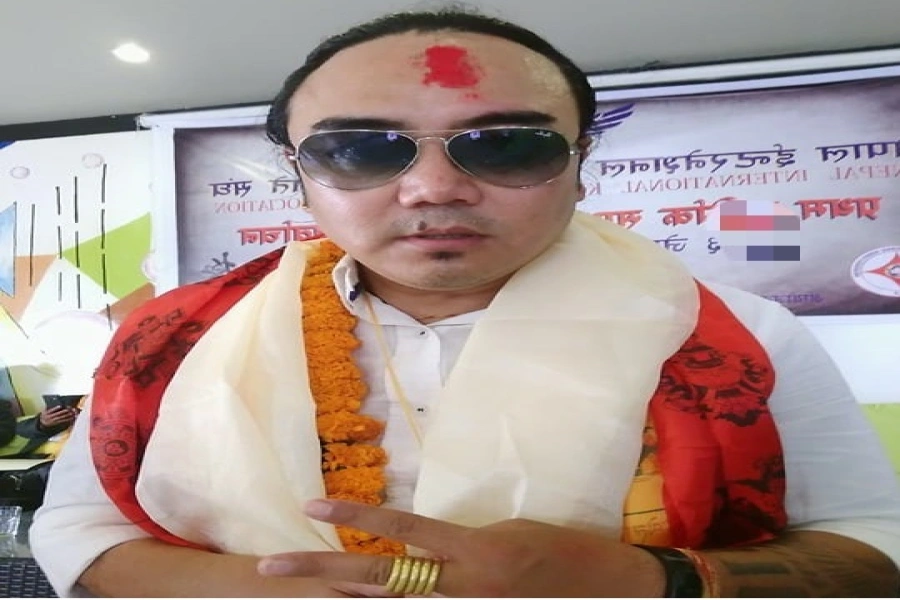Retrospection on the BFA Solo Exhibition Project 09 had the new batch offering varied perspectives on contemporary art in Nepal. It saw students working on youth culture, traditional patterns, religious and cultural philosophies to modern installation art, and sculpture.[break]
The exhibition project marked a major leap for the students crossing over to become eminent artists in the future. This is the first batch in Nepal to complete four years of Bachelor-level course in Fine Arts. It now gives them the opportunity to further pursue their studies in any major art colleges abroad. We sadly say abroad, as there are still no further courses available for Fine Arts studies in Nepal.
The final three art exhibitions of the BFA Project 09 were held in interlacing manner.
Pukar Risal, with his attitude of always thinking outside the box, gave us a taste of his creativity in his cubical sculpture series entitled “Outside the Box, Within the Box.”
Narayan Prasad Bohaju’s “Color of Horizon” opened the very next day of Pukar’s exhibition at the same venue, Nepal Art Council at Babar Mahal. Bohaju’s color of horizon was all green, expressing his hope for freedom, coolness and everything which everyone reaches out for.
The concluding show was that of Sunita Maharjan’s. Her series, poetically entitled “Locus of Continuity,” displayed the disarranged lines in different lights, and attempted to harmonize and connect with the onlooker at the emotional, intellectual and spiritual level.
Narayan Prasad Bohaju: Color of Horizon

Green – coolness, freedom, nature, life, hope, and wishes. For Narayan Prasad Bohaju, a final-year BFA student at Kathmandu University’s Center for Art and Design, the color green symbolized all these and more at his exhibition.
Each one of Bohaju’s paintings in the series was dominated with green. He said every one of us is searching for the coolness and the calm of green. He drew disparate empty water pots placed in a serpentine queue, this too being predominant in the series. He said they too are asking for something – something green – by opening their spouts to the sky.
There are partially visible human forms walking, or in their vehicles, heading somewhere in the crowds, and the canvas backgrounds seen through the gaps is filled with green.
“People walk, searching their ways, and thinking probably that by the end of the horizon, they will find their contentment and calmness. But the more you try to reach it, it just moves farther away.” Bohaju told us about his theory: “That’s why I call green that ever-elusive horizon.”
Drawing landscapes of his beloved hometown Bhaktapur was what he loved to do from his very childhood. For the sentimental artist, a walk around the town, the fields and the surrounding forests and streams in the past gave him a sense of freedom. Through his paintings, he laments for the lost past, and tries to draw our attention to his displeasure at the continued environmental degradation and increasing problems like the dire water shortage.
Load-shedding was a major hindrance during the six months that Bohaju, along with his graduating fellows, had to prepare their individual solo exhibition series. Bohaju credits the outage for one of his paintings, where he draws bulbs all blacked out, and the background, again, is – green!
“The bulb is for lighting; but during a blackout, it loses its existence. That’s what’s apparent everywhere, from bulbs to empty pots and to people.”
Bohaju chooses to walk around facing the ground. He says, “I’m more free in my thoughts when I look at the ground. There’re no questioning faces blocking me or my imagination.”
He adds that this gives him a sort of inspiration to start his work. We often see his hikes visually coming out on his canvases, where he just focuses on footsteps and the green roads they walk on.
After his SLC final exams, the Lalit Kala Campus was his ultimate choice for further studies.
“I was never good at studying. Though my parents, being from agricultural background, had no idea about art, they still supported my decision to study it,” said Bohaju, looking at his parents at the opening ceremony, curiously viewing their son’s paintings.
For Bohaju, art has always been about a self-satisfying experience, first and foremost. He believes most artists paint for themselves, without thinking about the reaction of viewers. “For me, too, as an artist, my satisfaction comes first.”He shared his view on art.
“People have questioned me about my abundant use of green in the series. But green was what I desired, and green was what my paintings and I needed for satisfaction.”
“His series has succeeded well in encapsulating the entire scale of the artist’s concerns on his canvases,” thus commented senior artist and art writer Madan Chitrakar. “Though there remains a fear of bewilderment in viewers because of the diverse sets of images involved, the artist’s adept display of artistic judgment justifies the chosen thoughts of the painter.”
The artist himself is still in search of green. He said this series was about the expressions of people reaching out to grasp their wishes, and in turn, it has evoked him to reach out for his horizon – his green.
Bohaju’s “Color of Horizon” opened on June 18 at the Nepal Art Council and concluded on June22.
Pukar Risal: Out of the box, within the box

Juggling his career as an interior designer and his student life at Kathmandu University’s Centre for Art and Design, Pukar Risal managed to incorporate his skills and his learning into his BFA Solo Exhibition Project.
The series was entitled “Out of the Box, Within the Box” and opened at the Nepal Art Council on June 17.
The challenge here was to think outside the box and pour in the creativity and artistic spirit into the boundaries of a simple form of a box – cubes, to be specific.
“I have always had a natural inclination towards the minimalistic art approach in experimenting with used objects in their simplest and most basic of shapes. Cubes fitted best to my idea of minimalism,” shares Pukar.
Most of his sculptures in the series are fired hollow clay cubes, using the Raku technique. The raku firing process developed in 16th century Japan is a very new technique in Nepal.
For most Nepalis who are unaware of this interesting process, a short procedural introduction was displayed at the exhibition.
In short, the process involves firing the clay figures rather quickly in very high temperatures that run upto about 1,800-2,000 degrees Celsius. The figures are then placed with different combustible materials along with different chemically influenced glaze compositions that give a unique color and smoldering effect to each piece. The red hot clay pieces are then instantly submerged in water to cool them. The last step either breaks the piece, or it survives, and is beautiful forever.
But Pukar opines that the main focus of his series is to experiment with cubes rather than raku.
“Raku is something I want to learn, but it was my love for cubes that gave rise to this series,” He says. After a workshop on ceramics, he was intrigued to making controlled cubes out of clay. When he was introduced to the unpredictable and uncontrolled technique of raku glazing, it offered him immense possibilities to play in the six facets of cubism.
The series, then, has been about uniting uncontrolled behaviors within the controlled dimensions of cubes.
This theme is not just apparent in his rakuwares but in the others of his interesting pieces as well. One of his most sought-after pieces entitled “Chaos” is a demonstration of a two-dimensional chessboard in a cube. This hanging piece in the gallery uses metal sheets formed into a cube, with chess pieces glued to it.
“Imagine how a chess player would make his moves on a three-dimensional board. It’s all upside down, chaotic and uncontrolled. All these facets are delivered in this perfectly controlled cube.”
He has used circular plates to form cubes, and wooden fixtures to prepare Swastika signs in cubical dimensions. His hexahedrons become holy for him when he demonstrates that cubes have been a symbol of the Earth in Platonic theory. Spotting his three cubes with a golden glaze, he tells us, “The gold leafs are symbolical homage to the Earth, and in Buddhist concept, they are offered in the odd number of three,” Pukar explains the deeper meaning of his cubes.
With quite a number of his pieces already marked “Sold” by the second day of his exhibition, Pukar says people have definitely appreciated his works, and his experiment with raku process. Their reaction is mixed, though.
“One viewer came to me and said he liked my work, especially the framed test piece which involved using human hair to bring out the pattern on it. But none of the pieces touched him, he said,” Pukar shares his viewer’s feedbacks.
Busy with designing and commissioning kitchens at present, he takes time out for college in the morning, and throughout the day, he pursues his career. After completing his course in interior designing, he wanted to take a course in product design. But with no such courses available in Kathmandu, he took to sculpture as a base for his artistic growth.
With supportive parents by his side, Pukar says, “My works aren’t new for them, as they’ve always been appreciating my experiments.”
This series, too, which he calls “An amalgamation of chemicals, ceramics and art” has been a fulfilling venture for him. Despite the mixed reviews his works have received, he, all the same, sees his cubes and his own self evolving far and wide – even well after the exhibit ends.
Pukar’s weeklong exhibition concluded on June 23 at the Nepal Art Council, Kathmandu.
Sunita Maharjan: Locus of continuity

“Line is life and life is a line.”
Sunita Maharjan started painting her present series for her BFA Solo Exhibition Project with this simple concept.
In the series aptly titled “Locus of Continuity,” Sunita paints lines and uses threads in the form of lines in almost each piece. She relates lines with the continuity of life and nature, and tries to capture this inseparable bond between the line and life.
Uttam Nepali, the eminent artist and poet who inaugurated Sunita’s exhibition at Hotel de l’ Annapurna, talked on abstract art. He emphasized that the real beauty of abstract art can be perceived only when we grasp it in abstract forms, rather than searching for some concrete forms we can relate to.
“It’s very impressive that Sunita, at her delicate age, has the ability to create such beauty, and works with a fully grown idea,” added Nepali while commenting on Sunita’s paintings.
“I don’t actually focus on my work as abstract,” says Sunita. “Though visually abstract, lines for me aren’t just for creating forms on my canvases, but it’s a complete entity in itself that depicts the flow, the movement, and the force within it.”
Her paintings that are a result of her fascination with haphazardly hung electric wires capture the flexibility, flow and disarrangement of the lines. But the wire-like forms and the background, mostly in bright colors and in their disarrangement, flexibility, overlapping, and in their natural momentum are what, ultimately, her works are all about – connecting.
With so much of twists and turns in life, people’s attempts to control their sentiments create a flow, and the line overlaps, comes back, yet never stops.
“My works are an attempt to find the balance between the human need to control and the inevitability of continuity,” Sunita says.
She makes use of jute threads in many of her paintings. She tells us that when she unwound the threads, each strand was straight and corresponded with the other when being placed on the canvas. But each thread took its own flow and momentum.
“It reminded me of how we all follow certain people or ideas, yet each one of us has a different pace and a different flow.” Sunita thus puts in her thoughts in a dazed state. Thus connecting life and her lines, she has her muse in creating her artworks.
During a student-exchange program, Sunita, along with four other fellow painters, had showcased their work in the Netherlands. There, too, she worked with color-dyed threads and lines on her paintings.
Though she has repeatedly used lines and wires with the theme of continuity, Sunita says she has no fixed plan to continue with the same idea.
“All of my works have been different. I feel newness comes in my works with the force and the movement within me.”
Many artists research on their subject matters before they start their work. But Sunita is one of those artists who have the tendency to work completely absorbed in her own creative thoughts and imagination.
While growing up, Sunita was mostly confused about what she wanted to do in her life. She was certain at least that she was not at all interested in studies. After her SLC exams, and when she joined the Lalit Kala Campus, she began exploring her interests in painting, and eventually it became a kind of her lifeline. This line for her has now given her the continuity and the drive to move on in her life with a motive to create art, content in herself, and content in her work.
Sunita Maharjan’s “Locus of Continuity,” which concludes the BFA Solo Art Exhibition Project of the graduating batch of Kathmandu University’s Centre for Art and Design, opened on June 19 and will continue to June 30 at Hotel de l’Annapurna on Durbar Marg in Kathmandu.
Three recycling musketeers




































